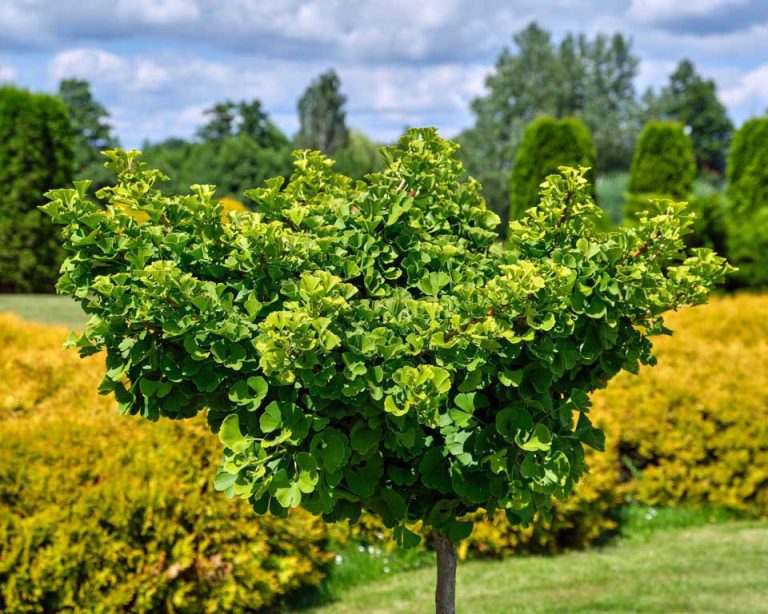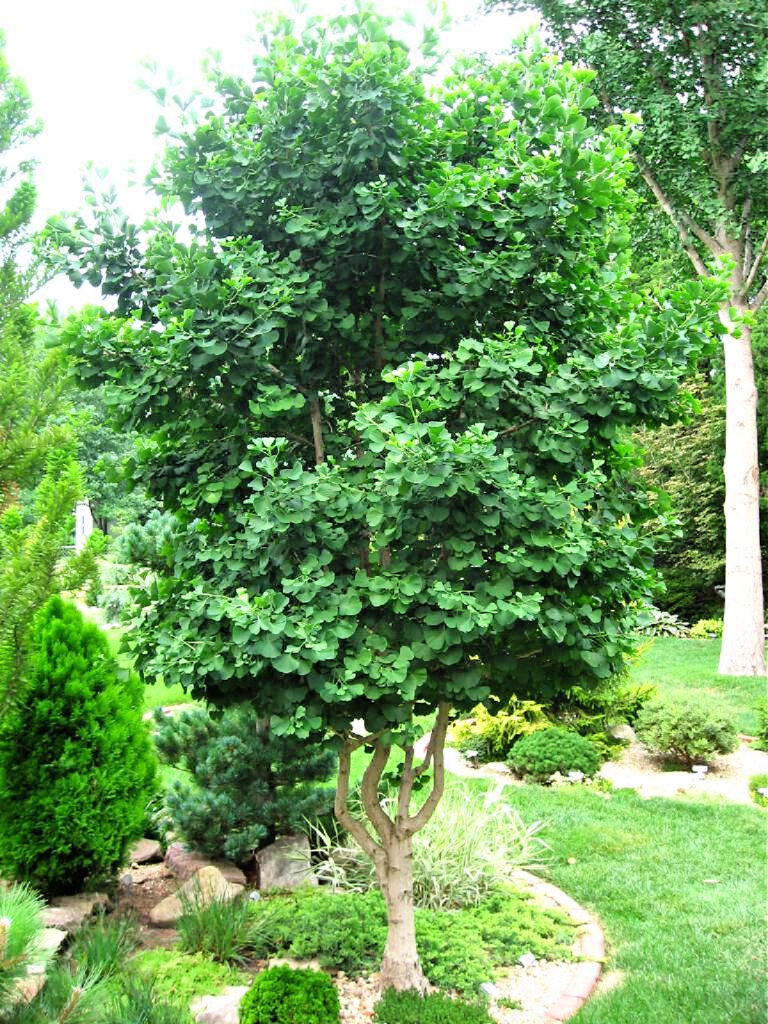I’ve had much interest in the fact that I have two trees growing in pots on my patio. One is a Ginkgo Biloba Jade Butterfly tree and the other is a Japanese Maple.
I purchased the Ginkgo Biloba tree about 4 years ago and it has since been repotted. As has the Japanese Maple, which I’ve had 2 years.
The Meyer lemon tree is naturally a small tree. It might achieve a dwarf size of 7 feet. So it can grow nicely indoors or on your patio. It should have plenty of food production of lemons year-round.
While the plants can tolerate a bit of shade, they prefer at least eight hours a day of direct sunlight.
Keep the soil moist but not soggy. Stick your finger into the soil at least up to the second knuckle. If you feel dampness at your fingertip, wait to water. If it feels dry, water your plant until you see water run out the bottom of the pot.
Japanese Maples have gorgeous leaves and will look quite nice on your patio. You can find the Coral Bark Japanese Maple here.
For a healthy container grown Japanese maple, you’ll need to plant the tree in a container that is about twice the size of the tree’s root system. The pot must have drainage holes to drain water.
Keep the soil moist but not wet. And use good quality potting soil to fill the pot.
My Japanese Maple can’t tolerate full sun in the middle of summer. Probably because it’s on a cement patio, even though it’s raised a bit on a plant caddie.
Another tree that will provide food for you is the Celeste Fig Tree. This tree is one of the most widely planted fig trees in the US.
A container suitable for planting fig trees in pots should be large. Half whiskey barrels are ideal. But any container large enough to accommodate the root ball plus some growing space is fine.
You can use regular organic potting soil or make your own mix as long as it is loamy, well-drained and contains plenty of compost or well-rotted manure.
Water deeply at least once a month in the summer to rinse away salt deposits as well as to get water to deep roots. Fig trees grown in containers will generally need to be watered more often, especially when outdoor temps climb above 85 F.
Placing the pot on casters makes for ease of movement if the tree needs to be moved during cool months to a protected area.
Figs crave sun, so choose a site with as much exposure as possible, preferably next to a south-facing wall. Plant new fig trees in the spring after all danger of frost for your area has passed.
This tree is also available at Etsy and you can find it here.
Another patio tree to consider is the Dwarf Peach Tree. You can find this one at Amazon. This particular one is 5 gallon but you can also purchase the 3 gallon size.
When planting, fill pot half-way with a loamy compost soil. Place the sapling into the container and fill under and around the plant. Fill the soil to within a couple inches of the top of the container.
Be sure to plant the tree so that the graft line (where the dwarf was grafted to its parent) is not under the soil.
A peach tree will benefit from being grown in a container since it produces flowers as early as March. It also bears fruit earlier than many fruit trees.
The container makes it easy to protect your peach tree by moving it indoors if frost or wind threatens the tree.
Ginkgo biloba, also known as the maidenhair tree, is a unique and ancient deciduous tree that can live for thousands of years. With its attractive fan-shaped leaves and tolerance of urban conditions, the ginkgo makes an excellent container-grown specimen for gardens of all sizes.
Growing ginkgo trees in pots allows you to have this majestic plant even if you don’t have space to plant it in the ground. With the right care and selection of compact varieties a potted ginkgo can thrive for decades.
Benefits of Growing Ginkgo in Containers
There are several key advantages to cultivating ginkgo trees in containers:
-
Versatility – Pots provide flexibility in placement and allow you to move the tree as needed to optimize light exposure, temperature regulation, and protection.
-
Size control – Container confinement helps restrict root and canopy growth. This lets you grow ginkgo even in a small courtyard or balcony setting.
-
Ease of care – It’s simpler to water, fertilize, and protect potted ginkgos compared to in-ground specimens. You can also bring them indoors if conditions require it.
-
Unique styles – Container-grown ginkgos can be trained into different shapes like standards, cascades, and bonsai forms.
Selecting a Ginkgo Variety for Containers
While some ginkgo varieties can reach 60-80 feet tall at maturity, there are more compact cultivars better suited for pots:
-
‘Tubifolia’ – A dwarf male cultivar that slowly reaches just 4-6 feet tall and 2-3 feet wide.
-
‘Mariken’ – This dense, rounded female selection grows only to 4-5 feet high and wide
-
‘Presidential Gold’ – A narrowly columnar male form that tops out around 10 feet tall by 2-3 feet across.
-
‘Jade Butterflies’ – An extremely dwarf female that reaches just 18 inches high and wide at maturity.
-
‘Chi Chi’ – Dense, bushy growth to 6-9 feet makes this female variety an ideal container candidate.
For pots, select compact, slow-growing varieties that max out under 10 feet tall. Male cultivars are preferable since females produce messy fruit.
Growing Ginkgo Trees in Containers
Follow these tips for successfully cultivating ginkgo in pots:
-
Soil – Use a well-draining potting mix amended with compost or bark. Ginkgos grow best in fertile, loamy soils but tolerate most types.
-
Pot size – Choose a container only 1-2 inches wider than the current root ball. Allow a bit of room for growth around the sides.
-
Watering – Ginkgos are drought-tolerant when mature but need frequent irrigation as young container plants. Allow soil to dry slightly between waterings.
-
Sunlight – Place in full sun to partial shade. A south-facing location is ideal. Ginkgos can adapt to light shade conditions.
-
Fertilizer – Feed with slow-release fertilizer pellets or monthly doses of balanced liquid fertilizer during spring and summer.
-
Pruning – Trim only as needed to maintain shape and remove dead branches. Avoid heavy pruning that stresses container ginkgos.
With proper drainage, adequate moisture, full sunlight and regular feeding, potted ginkgos can thrive for years as beautiful living sculptures. This hardy ancient survivor readily adapts to life in containers.
Tips for Growing Healthy Container Ginkgos
Follow these additional tips to keep your potted ginkgo trees looking their vibrant best:
-
Gradually acclimate indoor ginkgo trees to the outdoors each spring once temperatures have warmed up. This will harden them off for the growing season.
-
Rotate pots regularly to promote symmetrical growth through even sunlight exposure on all sides.
-
Prune back any roots that escape from drainage holes to prevent the tree from becoming root bound.
-
Repot every 2-3 years in early spring using fresh potting soil. Move up just one container size at a time.
-
Place pots on rolling plant caddies to simplify moving them for maintenance. Add casters for extra convenience.
-
Monitor for pests like spider mites, scale, and cankerworms. Treat any infestations immediately and aggressively.
-
Protect outdoor ginkgos from harsh winter winds with wraps or placing pots behind windbreaks.
-
Consider grafting varieties onto dwarfing rootstock like ‘Chi Chi’ to further restrict size.
With proper care, you can enjoy the unique beauty of ginkgo for many years in patio containers. This ancient survivor readily adapts to potted life with grace.
Frequently Asked Questions About Growing Ginkgo in Pots
Here are answers to some common questions about cultivating ginkgo biloba in containers:
Can I grow a ginkgo bonsai tree?
Yes, ginkgo makes an excellent bonsai specimen. Opt for slow-growing cultivars like ‘Tubifolia’ and ‘Jade Butterflies’. Use bonsai techniques like wiring and clipping to train the shape as desired. Repot annually.
What size pot does a ginkgo tree need?
Choose a container 2-4 inches wider than the root ball for mature 10-foot trees. Use at least a 20-inch diameter pot. Dwarf varieties only need 10-12 inch pots.
How often should I fertilize a potted ginkgo?
Apply slow-release fertilizer tablets every 2-3 months during the growing season. You can also use a dilute liquid feed every 4-6 weeks from early spring through mid-summer.
Can I grow ginkgo indoors as a houseplant?
Ginkgo can make a striking indoor plant if given ample sunlight from a south window. Use grow lights to supplement natural light. Maintain minimum temperatures above 60°F for winter dormancy.
With the right cultivar selection, setup, and attentive care, growing ginkgo biloba in containers allows you to enjoy this captivating tree even in a small space, indoors or out.
Conclusion
Growing ginkgo biloba in pots and containers is an excellent option for gardens both big and small. Follow the tips in this guide to choose the right variety, provide ideal growing conditions, and keep your potted maidenhair tree healthy and thriving for decades to come. With its resilience, graceful beauty, and living fossil status, ginkgo is a uniquely enchanting container plant like no other.

Ginkgo Biloba Jade Butterfly Tree

Above is a mature specimen of the Ginkgo Biloba Jade Butterfly tree. Mine isn’t that mature and filled out.
It is a deciduous conifer with a canopy of fan-shaped, beautifully variegated green, cream and butter-yellow leaves. In the fall the leaves turn bright yellow.
It is the only surviving member of a group of ancient plants believed to have inhabited the earth up to 150 million years ago.
Nurseries typically sell only male trees because female trees produce seeds encased in fleshy, fruit-like cone which, at maturity in autumn, are messy. The also emit a noxious, foul odor upon falling to the ground and splitting open.
Ginkgo biloba will grow best in part to full sun and is a splendid tree for the urban landscape. It is highly tolerant of many soils, pH, salt, and pollution. However, do make sure it is well drained.
You can find this tree for sale here.
USDA Zone: 4 – 9
If you are undecided about growing a tree in a container, I’d suggest going to a reputable nursery and talking to a tree expert.
